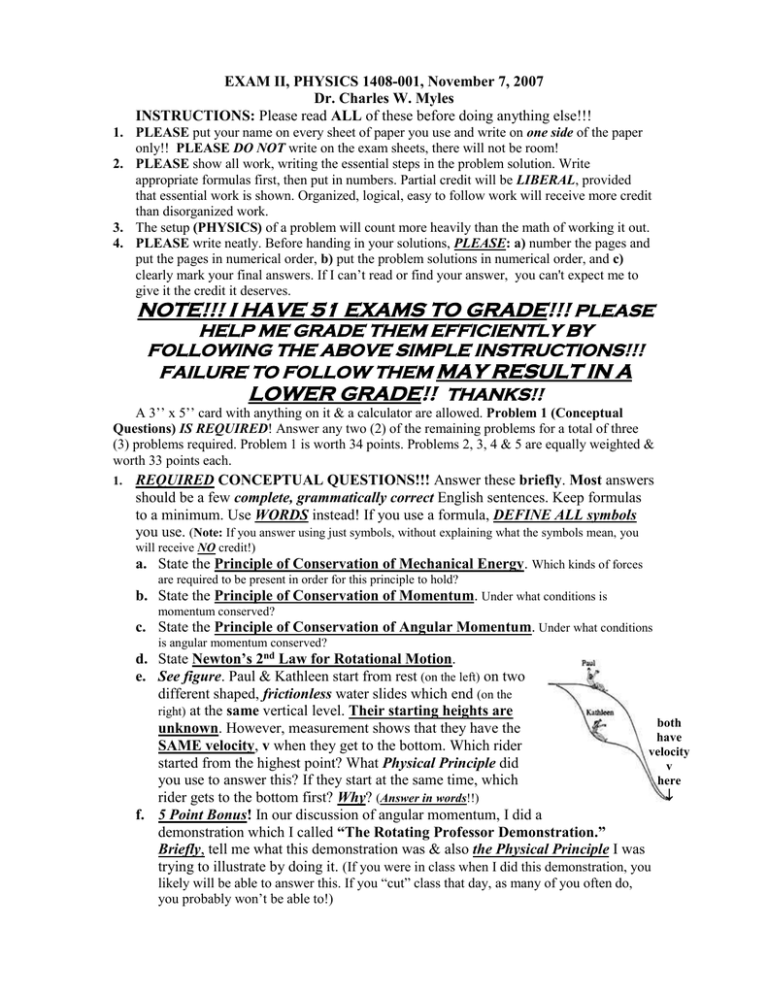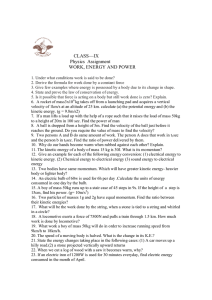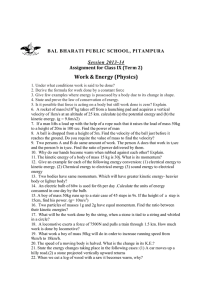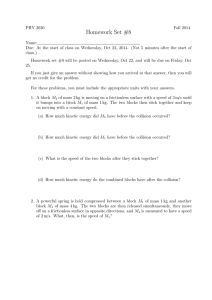EXAM II, PHYSICS 1408-001, November 7, 2007 Dr. Charles W. Myles INSTRUCTIONS:
advertisement

EXAM II, PHYSICS 1408-001, November 7, 2007 Dr. Charles W. Myles INSTRUCTIONS: Please read ALL of these before doing anything else!!! 1. PLEASE put your name on every sheet of paper you use and write on one side of the paper only!! PLEASE DO NOT write on the exam sheets, there will not be room! 2. PLEASE show all work, writing the essential steps in the problem solution. Write appropriate formulas first, then put in numbers. Partial credit will be LIBERAL, provided that essential work is shown. Organized, logical, easy to follow work will receive more credit than disorganized work. 3. The setup (PHYSICS) of a problem will count more heavily than the math of working it out. 4. PLEASE write neatly. Before handing in your solutions, PLEASE: a) number the pages and put the pages in numerical order, b) put the problem solutions in numerical order, and c) clearly mark your final answers. If I can’t read or find your answer, you can't expect me to give it the credit it deserves. NOTE!!! I HAVE 51 EXAMS TO GRADE!!! PLEASE HELP ME GRADE THEM EFFICIENTLY BY FOLLOWING THE ABOVE SIMPLE INSTRUCTIONS!!! FAILURE TO FOLLOW THEM MAY RESULT IN A LOWER GRADE!! THANKS!! A 3’’ x 5’’ card with anything on it & a calculator are allowed. Problem 1 (Conceptual Questions) IS REQUIRED! Answer any two (2) of the remaining problems for a total of three (3) problems required. Problem 1 is worth 34 points. Problems 2, 3, 4 & 5 are equally weighted & worth 33 points each. 1. REQUIRED CONCEPTUAL QUESTIONS!!! Answer these briefly. Most answers should be a few complete, grammatically correct English sentences. Keep formulas to a minimum. Use WORDS instead! If you use a formula, DEFINE ALL symbols you use. (Note: If you answer using just symbols, without explaining what the symbols mean, you will receive NO credit!) a. State the Principle of Conservation of Mechanical Energy. Which kinds of forces are required to be present in order for this principle to hold? b. State the Principle of Conservation of Momentum. Under what conditions is momentum conserved? c. State the Principle of Conservation of Angular Momentum. Under what conditions is angular momentum conserved? d. State Newton’s 2nd Law for Rotational Motion. e. See figure. Paul & Kathleen start from rest (on the left) on two different shaped, frictionless water slides which end (on the right) at the same vertical level. Their starting heights are both unknown. However, measurement shows that they have the have SAME velocity, v when they get to the bottom. Which rider velocity started from the highest point? What Physical Principle did v here you use to answer this? If they start at the same time, which rider gets to the bottom first? Why? (Answer in words!!) f. 5 Point Bonus! In our discussion of angular momentum, I did a demonstration which I called “The Rotating Professor Demonstration.” Briefly, tell me what this demonstration was & also the Physical Principle I was trying to illustrate by doing it. (If you were in class when I did this demonstration, you likely will be able to answer this. If you “cut” class that day, as many of you often do, you probably won’t be able to!) NOTE: Answer any two (2) of problems 2, 3, 4, & 5!!! 2. See figure. Use energy methods to solve this!!! NO credit will be given for force methods! You don’t need to know force components or the incline angle θ to solve k = 850 N/m m = 4kg this! A block, mass m = 4 kg, is on a horizontal, frictionless surface. It is pressed x = 0.25 m against an ideal spring, of constant k = 850 N/m, and is initially at rest, as on the left of the figure at point A. At point A, the spring is compressed a distance x = 0.25 m from its equilibrium position. The block is released and it moves first to point B, which is at the bottom of a frictionless incline. It then moves up the incline and stops at point C at the right of the figure, at a height h above the original position. a. Calculate the elastic (spring) potential energy of the block at point A. b. Calculate the block’s kinetic energy & it’s speed at point B. What Physical Principle did you use to do this calculation? c. Calculate the gravitational potential energy of the block at point C & the height h at which it stops. What Physical Principle did you use? d. Calculate the velocity of the block when it is at height y = 0.4 m above the horizontal surface (not shown in the figure; above point B and below point C). m 3. See figure. A bullet, mass m = 0.032 kg, traveling at a speed v = M 325 m/s, strikes and becomes embedded in a wood block, mass M = 1.75 kg, which is at initially at rest on a horizontal surface. The v = 325 m/s block-bullet combination then to moves to the right across the surface. a. Calculate the momentum & the kinetic energy of the bullet before it hits the block. b. Calculate the momentum of the bullet-block combination as they move away from the collision. Calculate their speed V immediately after the collision. What Physical Principle did you use to find these? c. Calculate the kinetic energy of the bullet-block combination just after the collision. Was kinetic energy conserved in the collision? Explain (using brief, complete, grammatically correct English sentences!) (HINT: Please THINK before answering this! Compare the kinetic energy calculated here with that calculated in part a! NOTE: It is physically IMPOSSIBLE for the total kinetic energy to INCREASE in a collision! If the kinetic energy you obtain here is larger than that of part a, you’ve done something wrong!). d. Calculate the impulse Δp delivered to the block by the bullet. If the collision time was Δt = 1.4 10-3 s, calculate the average force exerted by the bullet on the block. What Physical Principle did you use to find this force? m M V=? NOTE: Answer any two (2) of problems 2, 3, 4, & 5!! 4. See Figure. A uniform solid sphere of radius R = 0.45 m & mass M = 6.5 kg starts from rest at the top of an inclined plane & rolls without slipping to the bottom of the plane and continues on a horizontal surface. Initially, it’s height is H = 8.3 m above the bottom of the plane. The sphere’s moment of inertia is I = (2/5)MR2. y = H = 8.3 m V=0 ω=0 Before y=0 V=? ω=? After a. Calculate the gravitational potential energy of the sphere at its initial position & it’s total kinetic energy when it reaches the bottom. What Physical Principle did you use in the latter calculation? b. Calculate the translational velocity V of the center of mass & the angular velocity ω of the sphere when it reaches the bottom of the plane. c. Calculate the translational kinetic energy of the center of mass of the sphere when it reaches the bottom. d. Calculate the rotational kinetic energy & angular momentum (about an axis through the center of mass) of the sphere when it reaches the bottom. F 5. The figure is an end view of a flat, uniform cylindrical satellite, of radius R = 5.5 m & mass M = 4,500 kg, which engineers are testing in a lab. It’s moment of inertia is I = (½)MR2. There are four (4) rocket engines, arranged 90° apart, at radius R and which, when fired F simultaneously, exert four (4) equal unknown forces F tangent to the circle as shown. They give the satellite an angular acceleration α = 0.3 rad/s2. Assume that the four forces F are only forces producing torques about the axis of rotation. F a. Calculate the net (total) torque exerted by the four rocket engines. What Physical Principle did you use to find this torque? b. Calculate the value of the unknown force F. The satellite starts from rest, and has an angular velocity ω = 30 rad/s after the rockets have been firing for a time t. c. Calculate the time t and the velocity v of a point on the rim at that time. d. Calculate the rotational kinetic energy and the angular momentum of the satellite at that time. F




